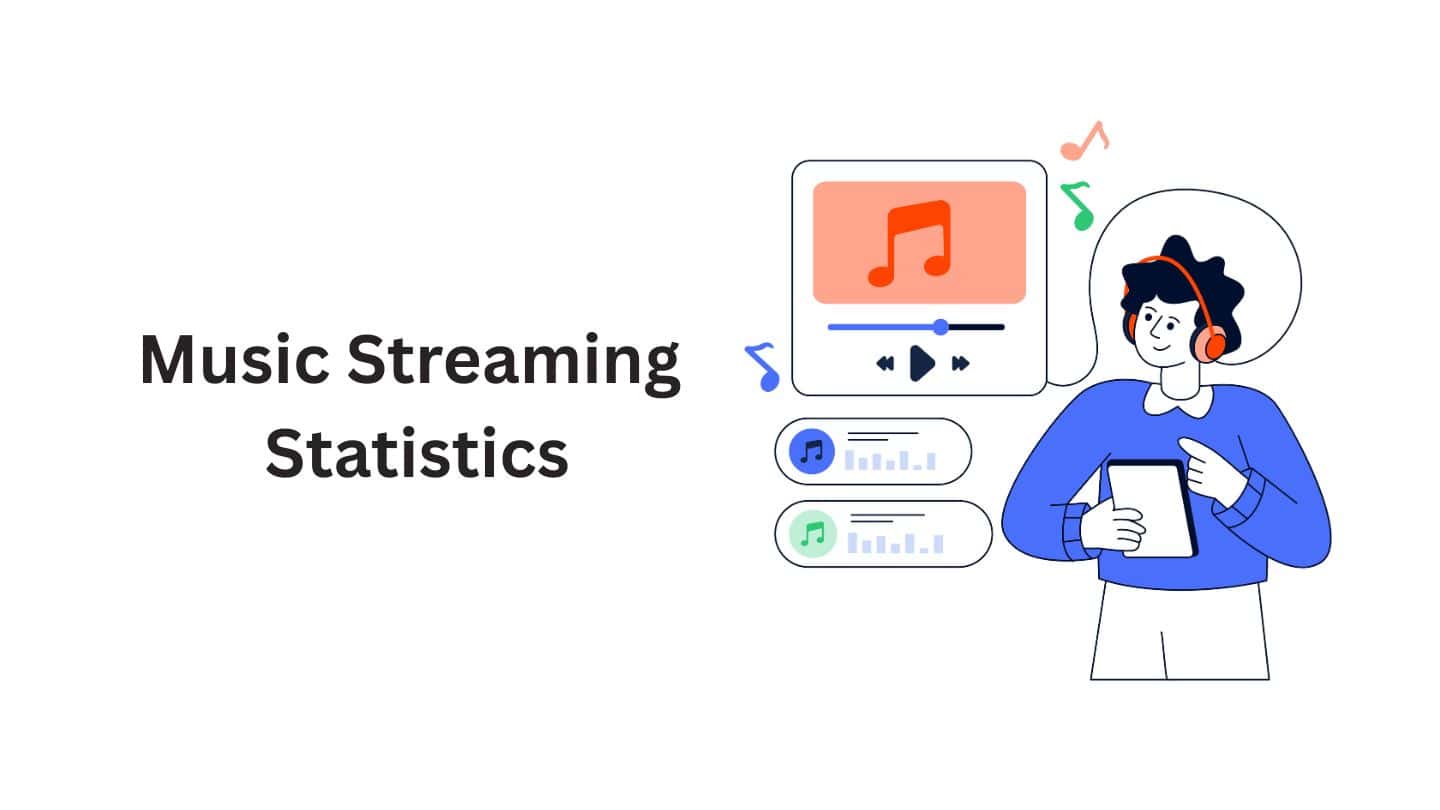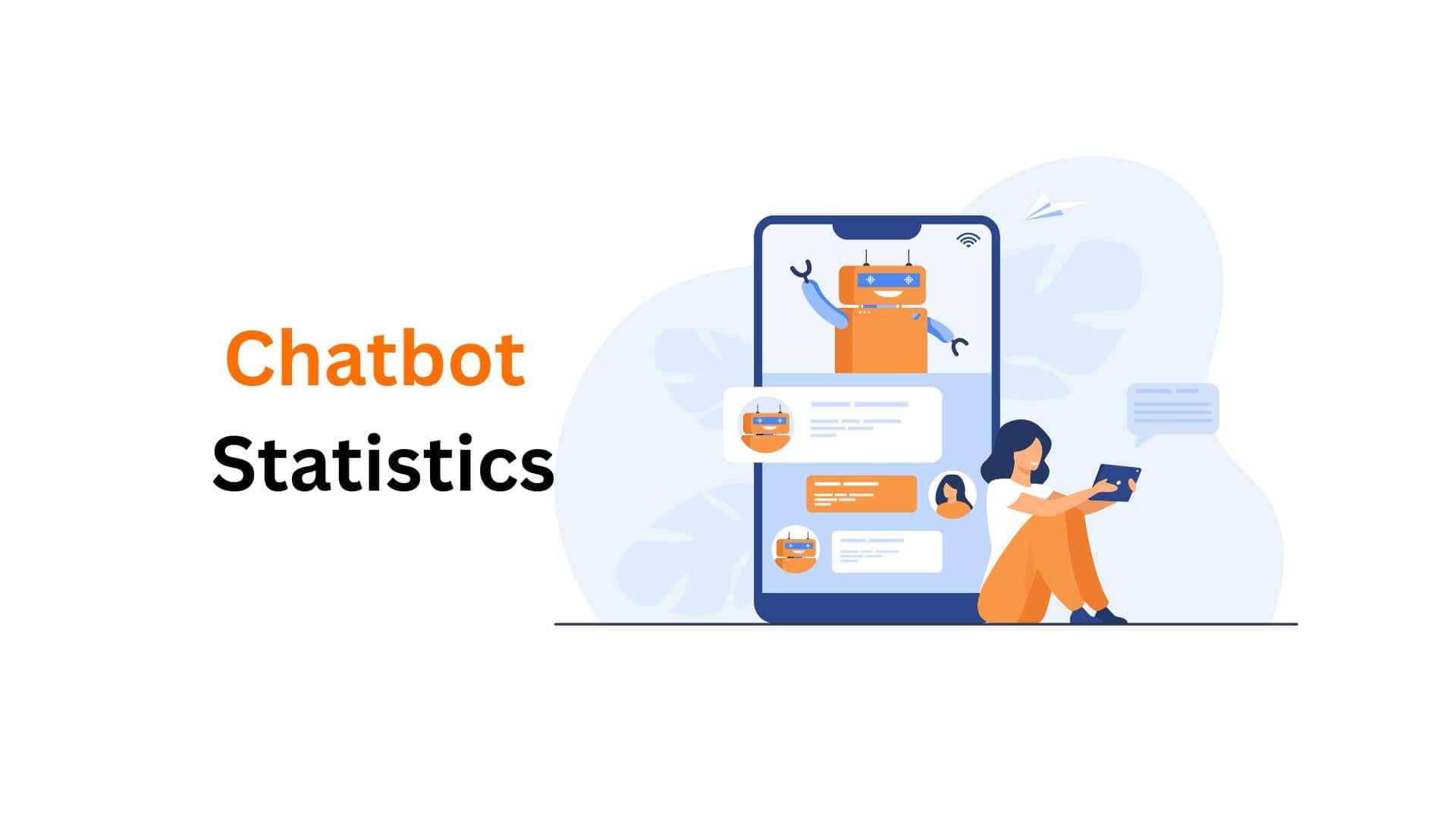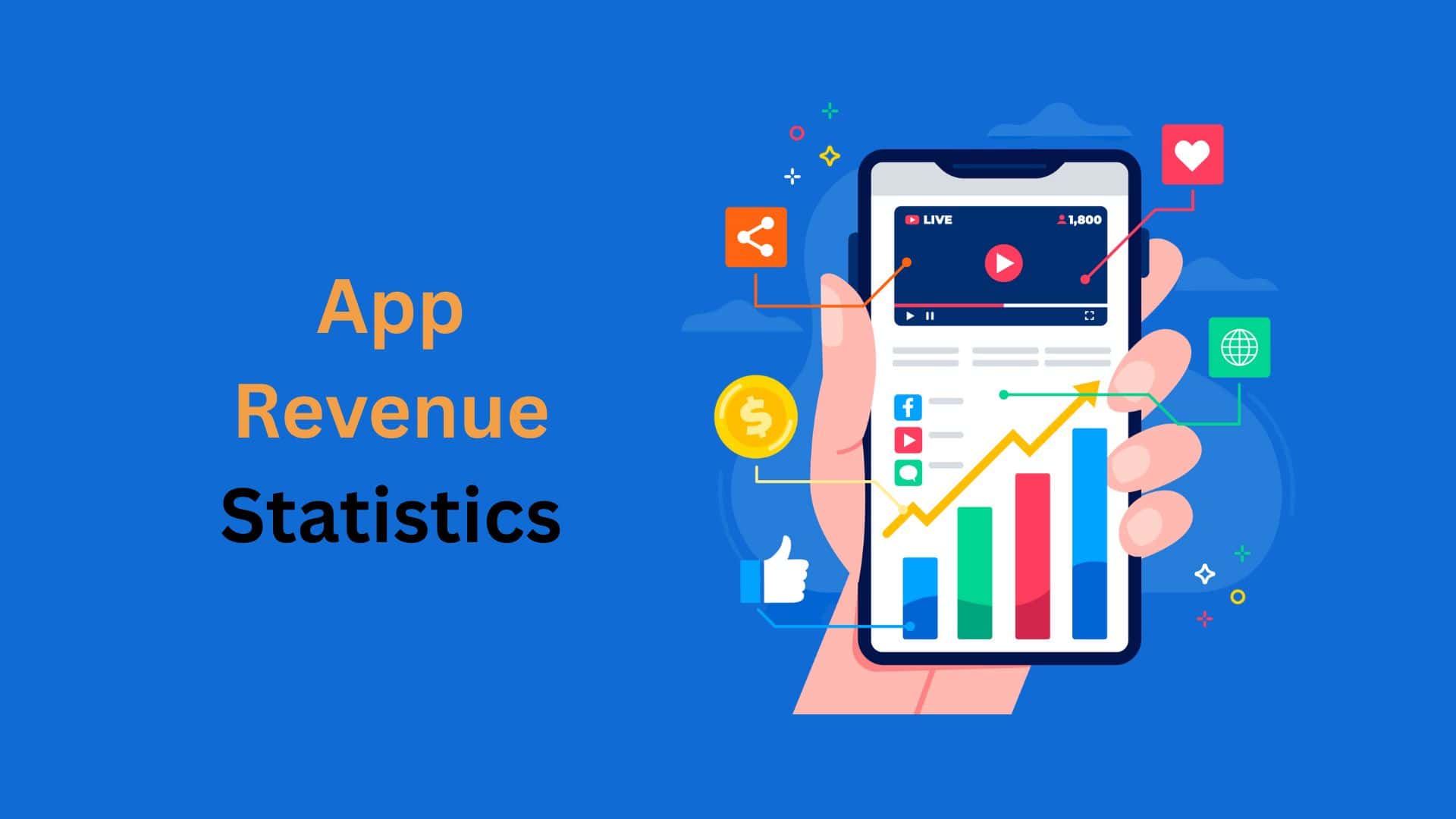Bootcamp Statistics By Market Size, Demographics And Facts (2025)

Updated · Aug 13, 2025

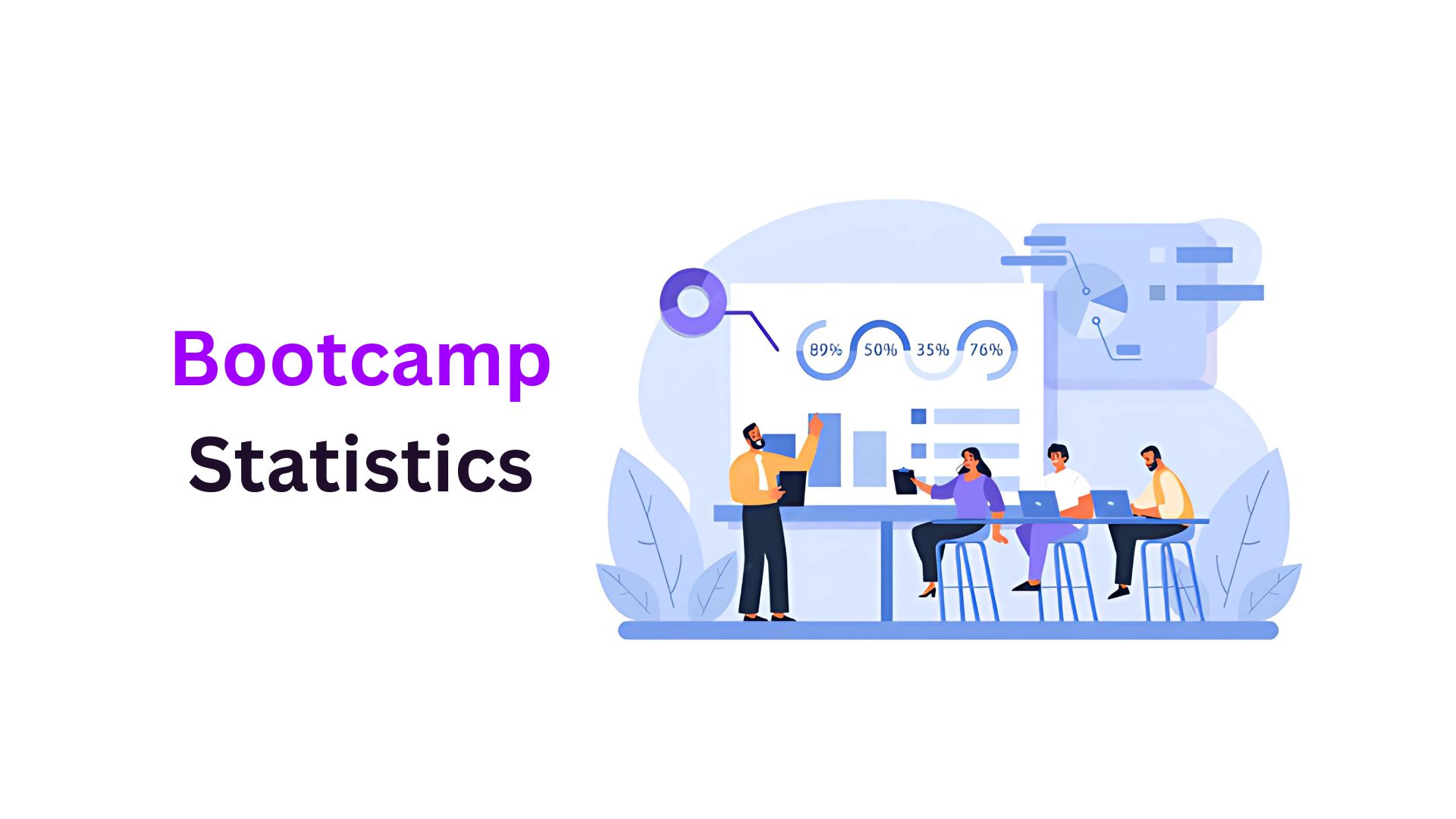
WHAT WE HAVE ON THIS PAGE
- Introduction
- Editor’s Choice
- Origins and Early Growth (How it all began)
- Market Size and Growth (How big is the industry)
- Who Attends Bootcamps (Demographics and Student Profile)
- Cost and Financing (How Students Pay)
- Curriculum and Popular Tracks (What Students Learn)
- Outcomes, Graduation, Completion, and Job Placement
- Salaries and ROI (Money Math)
- Employers and Hiring (Do They Hire Grads?)
- Risks, Criticisms, and Real-World Headwinds
- Future Outlook and Recommendations (What Students and Providers Should Do)
- Conclusion
Introduction
Bootcamp Statistics: When people talk about bootcamp statistics, it’s not just about random numbers floating around the internet. It’s about understanding the story those numbers tell. Over the last decade, coding bootcamps and other tech-focused training programs have transformed from niche experiments into a massive, global education model.
If you’ve ever wondered how many people join bootcamps each year, how much they cost, what the job placement rates look like, or which skills are most in demand, that’s exactly what I have addressed in this article. These statistics can show us everything we need to know about boot camp statistics.
From these, we can see where the bootcamp industry started, how fast it’s growing, and what kind of impact it’s making on careers and salaries. Think of this as your complete breakdown of the bootcamp world, from its origin to its current trends, so you can get a clear picture without the fluff. Let’s get into it.
Editor’s Choice
- Bootcamps took off around 2012 (Dev Bootcamp started the trend), then grew fast, hit quality and regulatory growing pains, and now only the outcome-driven ones with audited data are thriving.
- Global market size is projected to be around $3.8 billion in 2025; U.S. tuition revenue alone was roughly $800 million in 2023, and around 69,000 students are expected to graduate in 2024.
- Most students are in their late twenties (median age 30), often changing careers: about 50 to 60% have a bachelor’s degree, 32 to 36% are women, and many come with 4 to 7 years of non-tech experience.
- Heaviest programs (full-time immersive) cost around $14.6k; part-time programs roughly $12k, self-paced around $8.6k.
- The majority pay upfront (82%) or via installments (58%), with loans (53%) and scholarships (36%) common; only 5% offer ISAs now (down from hype days), especially after CFPB action against misleading agreements.
- Curriculum centers on full-stack web dev (JS, React, Node, SQL), with growing emphasis on AI basics, cloud, data science, UX, and cybersecurity.
- Within 180 days, 60 to 80% get jobs in the field, many within 3 to 6 months. Average starting salary is around $65 to 70k, with a lift of $22 to 25k from prior earnings, implying a tuition payback under a year (on paper).
- Employers are warming to bootcamp grads, especially in skills-focused settings; 50 to 70% express confidence in hiring them. What matters: real projects, portfolios, teamwork, and adaptability.
- Risks include variability in quality, misleading ISAs/financing, hiring slowdowns (especially with AI and layoffs), and boots that inflate outcomes. Always check for audited data (CIRR), clear financing terms, and realistic salary medians.
- Expect more demand for AI-aware, cybersecurity, and cloud skills; consolidation of trusted providers; more employer partnerships and apprenticeships; and tighter regulation on claims and financing.
| Topic | Key Numbers / Insights |
| Origins |
Started in 2012, rapid expansion, now only the outcome-driven survive |
|
Market Size |
Global $3.8B (2025); U.S. tuition $800M (2023); 69k graduates (2024) |
| Student Profile |
Age 30; 50 to 60% have degrees; 32 to 36% women; many career-changers |
|
Tuition |
Full-time $14.6k; part-time $12k; self-paced $8.6k |
| Financing |
Upfront (82%), installments (58%), loans (53%), scholarships (36%), ISAs (5%) |
|
Curriculum |
Full-stack web Dev (JS, React); growing AI/data/security content |
| Outcomes |
60 to 80% job placement in 180 days; Starting salary $65 to 70k; lift $22 to 25k |
|
Employers |
50 to 70% confident in hiring bootcamp grads; value project skills over degrees |
| Risks |
Quality varies; ISAs are risky; hiring volatility from macro shifts |
|
Outlook |
Focus on AI/cloud skills, audited outcomes, employer links, and tighter regulation. |
Origins and Early Growth (How it all began)
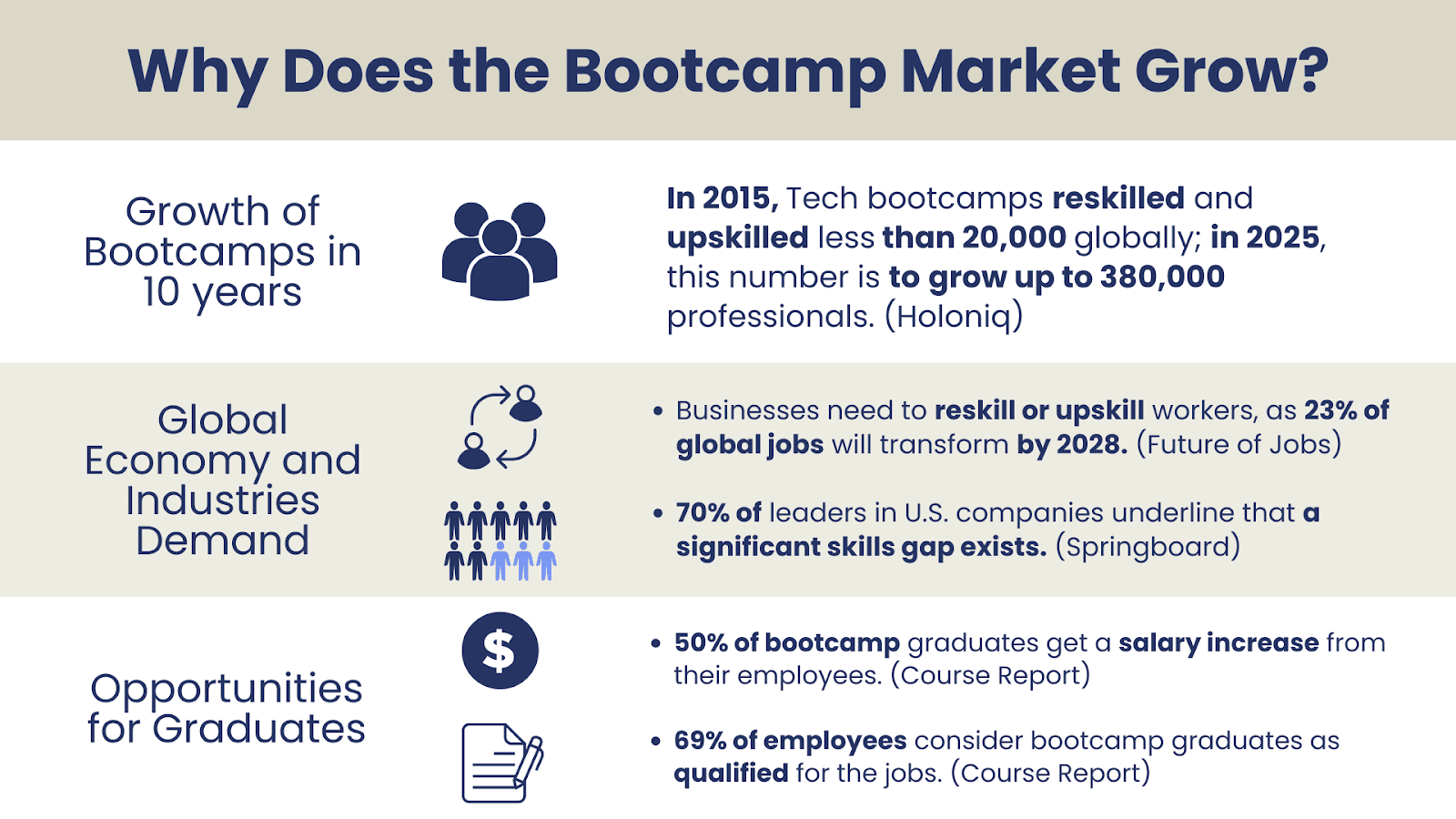
- The first modern, intensive coding bootcamp, often credited with kick-starting the movement, launched in 2012 (Dev Bootcamp).
- Between 2012 and 2015, dozens of new providers appeared (Flatiron, General Assembly, App Academy, Hack Reactor, etc.), and rapid replication drove fast graduate growth.
- Early marketing emphasized “job-ready in months” rather than years of college. That promise is the reason many students signed up.
- Investment and acquisitions followed: many bootcamps were acquired by larger education firms between 2014 to 2017.
- By 2016 to 2018, the market matured: emphasis shifted from pure growth to verified outcomes and transparency (CIRR and outcome reporting emerged).
- Several high-profile regulatory and legal problems (misleading claims, financing issues) surfaced mid-to-late 2010s and into 2024, driving closer scrutiny.
- Dev Bootcamp (a pioneer) closed in 2017, an early sign of consolidation and uneven quality.
- Bootcamps expanded globally after 2015; by 2024, the model exists in hundreds of cities and online.
- The pandemic pushed almost every provider online, which changed, mostly stuck (remote/hybrid model now dominant.
- The last few years saw a split: top outcome-focused schools (CIRR-audited) thrived; lower-quality operators either folded or were acquired.
| Metric | Key fact |
| First major modern boot camp | Dev Bootcamp (2012). |
| Early growth | Many new schools, from 2012 to 2016, followed acquisitions. |
| Regulation/oversight arrival | CIRR & outcome auditing (mid-2010s). |
Market Size and Growth (How big is the industry)
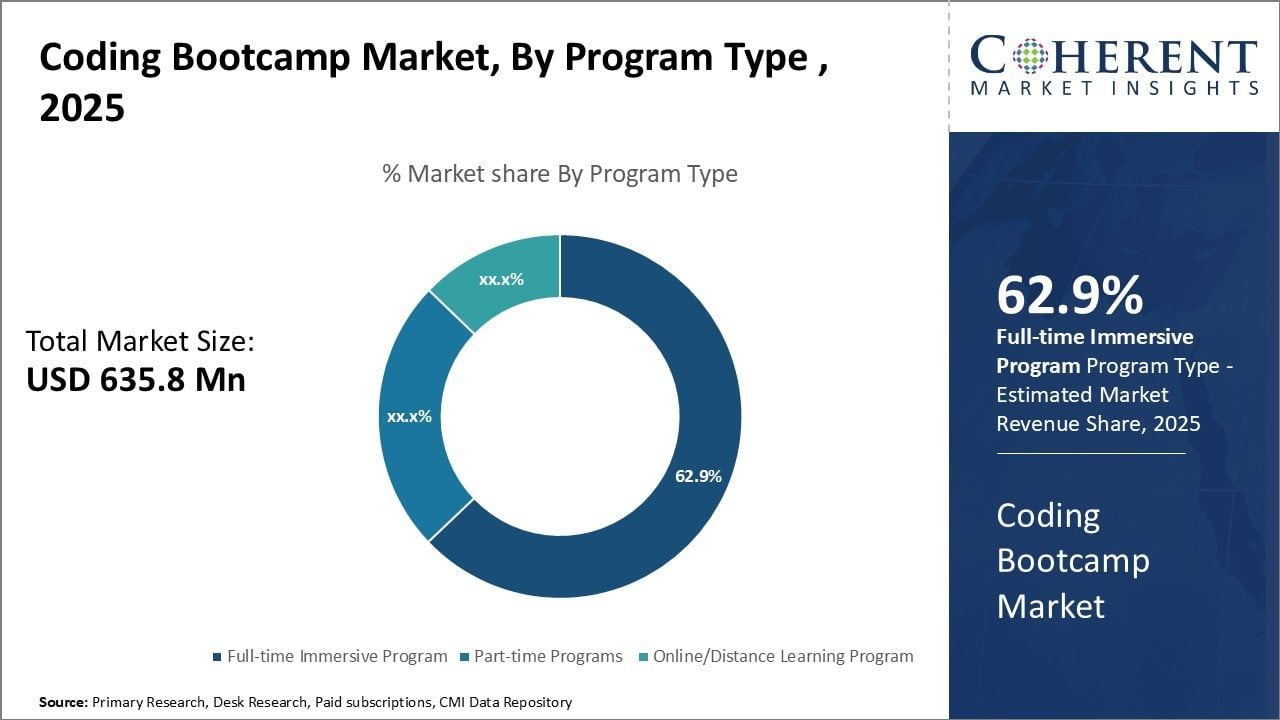
- Estimated global market value (multiple industry reports): USD 3.8 billion in 2025 (Mordor Intelligence projection for coding bootcamp market).
- Other market forecasters widely conservative tuition-revenue estimates for the U.S./major providers put 2023 tuition revenue near $801M, and projected $826M for 2024.
- Career Karma projected 69,000 graduates in 2024 (a mid-range industry estimate based on LinkedIn and provider data).
- Market CAGR estimates vary by vendor: some market firms show 9 to 30% CAGR depending on scope and definitions. That wide range reflects how “boot camp” is defined.
- The US remains the largest single market, but the model is expanding in the EU, LATAM, Africa, and APAC.
- Revenue sources: tuition (70 to 90% of reported revenue), corporate training, apprenticeships, government grants/initiatives.
- Average tuition reported in multiple studies $13k to $14k (global/US averages vary by format).
- Self-paced and part-time programs are cheaper on average; full-time immersive programs cost more. (Full-time average cited $14.6k in Career Karma dataset.)
- Market consolidation continues: smaller/low-outcome schools shrink or exit while stronger outcome-driven schools scale.
- Macro shocks (tech layoffs, AI shifts) produce short-term enrollment/recruiting changes and create volatility in projections. Recent reporting ties AI changes to lower demand for entry roles.
| Stat | Number / Range | Source |
| Global market (2025 est.) | $3.77B | Mordor. |
| U.S. tuition revenue (2023) | $801M (est) | Career Karma. |
| Graduates (2024 proj.) | 69,000 | Career Karma. |
| Avg tuition (overall) | $13k to $14k | Course Report & Career Karma. |
Who Attends Bootcamps (Demographics and Student Profile)
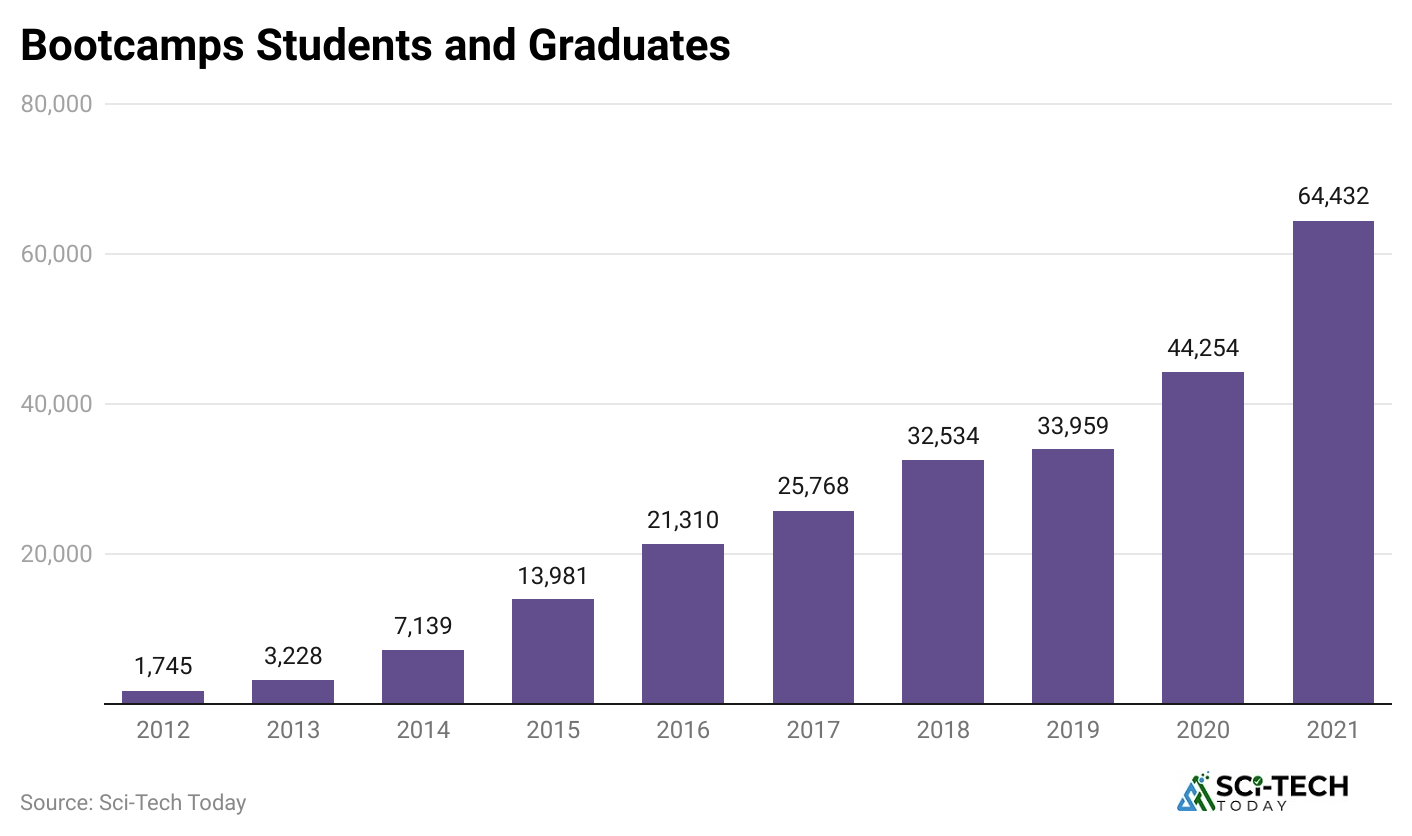
- Median/average age of bootcamp students is around 29 to 31 years old, and many are career switchers.
- A majority of enrollees have work experience (median years of experience is often 4 to 7 years before boot camp).
- Education: historically, 50 to 60% had a bachelor’s degree; that share has shifted slightly over time, with more “no-degree” entrants.
- Gender mix: women historically 32 to 36% of graduates (growing vs early 2010s).
- Racial/ethnic diversity: Bootcamps can be more diverse than traditional CS pipelines in some regions, but results vary widely by program and city.
- International students: Some programs recruit globally; online options increased international participation post-pandemic.
- Prior tech experience: Many grads did not work as programmers before boot camp. The bootcamp model is built for newcomers.
- Motivations: career change, salary increase, faster entry to tech, and employer upskilling. Surveys repeatedly list these as top drivers.
- Typical cohort size varies from small niche cohorts (10 to 20) to large online cohorts (100s).
- Veterans, underrepresented groups, and older mid-career learners are a means
| Metric | Typical figure |
| Median age | 29 to 31 years. |
| % with bachelor’s | 50 to 60% (varies). |
| % women (approx) | 32 to 36% (rising). |
| Typical prior experience | 4 to 7 years of non-dev work is common. |
Cost and Financing (How Students Pay)
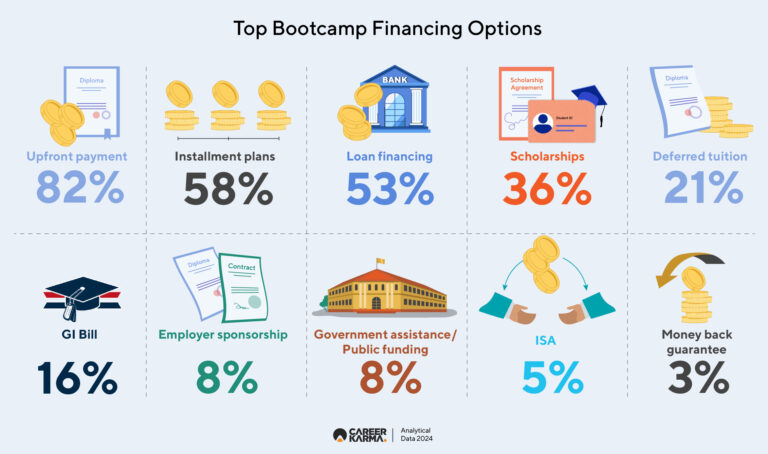
- Average tuition across many bootcamps sits in the $13k to $14k band (varies by format and region).
- Full-time immersive tuition averages higher (example: Career Karma reports $14,604 for full-time).
- Part-time and self-paced options are cheaper on average: Career Karma lists part-time $12,116 and self-paced $8,662.
- Financing mix in 2024 (Career Karma dataset): Upfront payment 82%, installments 58%, loans 53%, scholarships 36%, deferred tuition 21%, GI Bill 16%, ISAs 5%. That 5% ISA figure is a big drop from earlier years.
- Income Share Agreements (ISAs) were hyped but shrank in prevalence after regulatory scrutiny and abuses (CFPB enforcement action against BloomTech in 2024 is a major example).
- Private loan partners (Ascent, Climb, etc.) have common APRs that vary widely; some providers offer 0% deals in limited cases.
- Scholarships & diversity funds are increasingly used to recruit underrepresented groups.
- Many bootcamps offer deferred tuition / job-guarantee options with strict terms and job search obligations. Read the small print.
- For students, the typical payback math often assumes a salary lift, but results vary by city, role, and prior experience.
- Regulatory risk: improper financing claims led to enforcement actions and settlements (watch ISAs and lender disclosures)
| Item | Typical / 2024 figure |
| Avg tuition (overall) | $13k to $14k. |
| Full-time average tuition | $14,604 (Career Karma). |
| % of schools offering ISAs | 5% (2024 drop). |
| Common financing | loans, installments, and scholarships. |
Curriculum and Popular Tracks (What Students Learn)
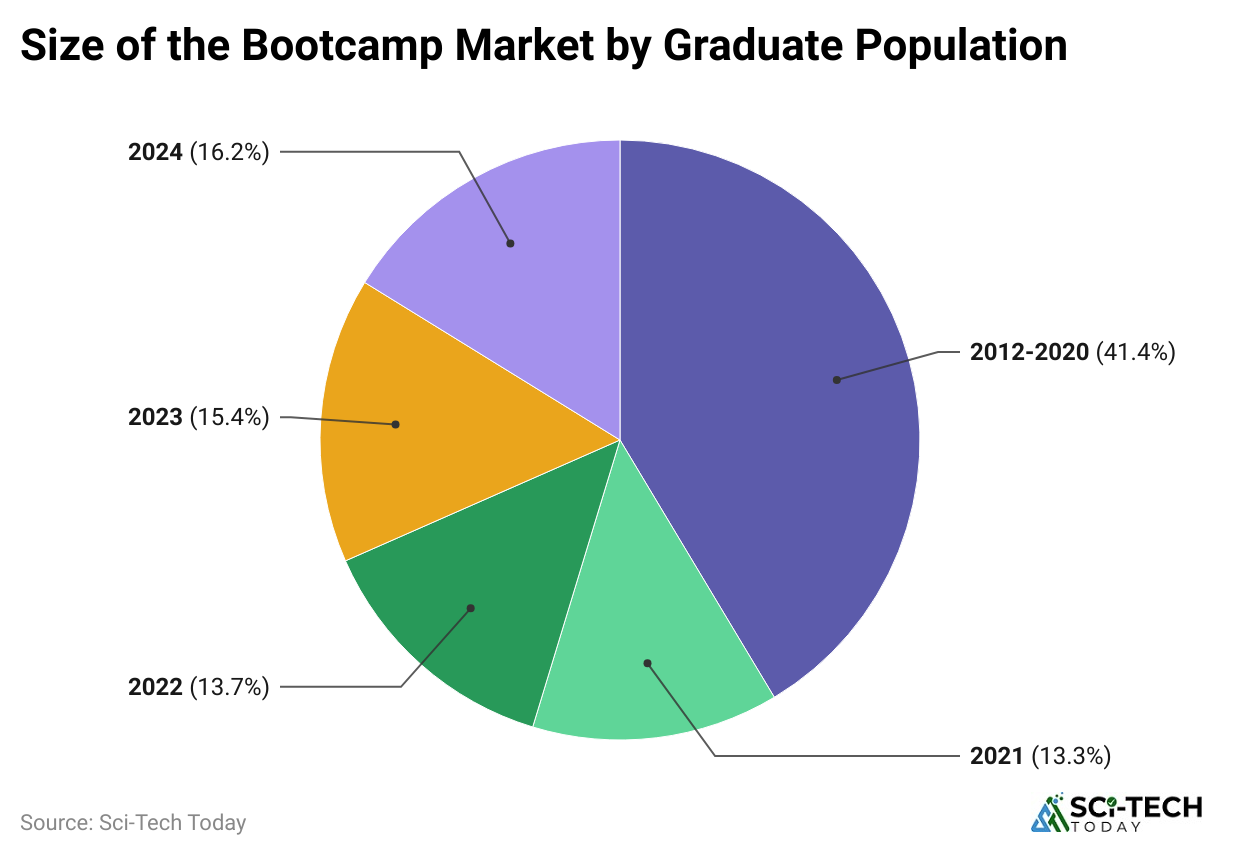
- Most common tracks: Full-Stack Web Development, Data Science / Data Analytics, UX/UI Design, Cybersecurity, Machine Learning / AI, Digital Marketing. Full stack is top.
- Average program length: various full-time immersives run 12 to 14 weeks; part-time programs run several months; some “bootcamps” run 6 weeks or up to 28+ weeks. The course report cites a 14-week average.
- Weekly intensity: full-time often 30 to 50+ hours per week, part-time 10 to 20+ hours depending on program.
- Hands-on project work is the core: students typically graduate with 2 to 6 portfolio projects.
- Tool/language mix: JavaScript + React + Node + SQL + Git remain dominant for web; Python + SQL + ML libs dominate data programs. Career Karma and Course Report list React, Git, and Node as commonly taught.
- Newer additions: AI literacy, prompt engineering, cloud basics, and cybersecurity fundamentals have been appearing in many curricula since 2023.
- Career services are standard: resume coaching, mock interviews, hiring days, and employer pipelines. The quality/quantity of placement support varies widely.
- Some top bootcamps publish audited outcomes (CIRR) while many do not; that’s a quality filter.
- University-linked bootcamps and microcredentials are growing; universities partner with providers to offer longer credentials.
- Specialized short bootcamps (cyber, product management, cloud) are rising as employers seek targeted skills.
| Track | Typical languages/tools taught |
| Full-Stack Web | JavaScript, React, Node, SQL, Git. |
| Data Science | Python, SQL, pandas, scikit-learn, ML basics. |
| Cybersecurity | Networking, Linux, detection tools, and basic forensics. |
| Avg length (full-time) | 12 to 14 weeks. |
Outcomes, Graduation, Completion, and Job Placement
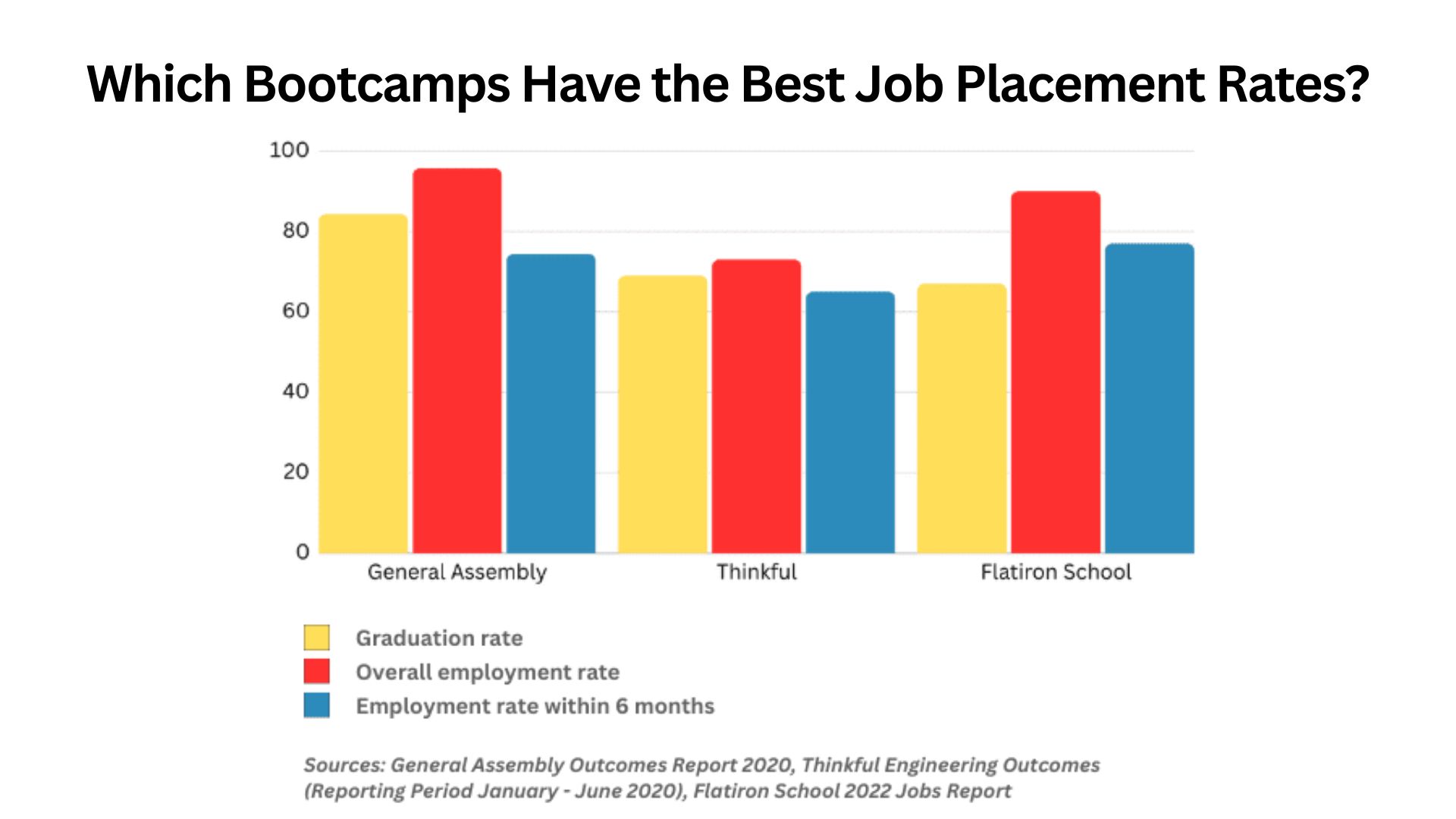
- CIRR member programs publish verified outcomes; aggregated CIRR data is the best hard source for comparable placement figures.
- Course Report surveys show the majority of graduates do find relevant work: Course Report median/average first-job salary numbers and the headline employment shares are often cited (average starting salary $69k).
- Employment within 180 days: broadly reported ranges 60 to 80% depending on program, with many top names above 80% and some lower-quality programs well below that. CIRR member averages have been reported near the low-70s in some recent summaries.
- Graduation/completion rates vary; some CIRR-reporting schools show high graduation rates (80 to 95%) while others have lower completion rates; industry averages are not uniform.
- Time-to-hire median: Many programs report that most placed grads get offers within 3 to 6 months; top performers often place many within 90 days.
- Outcomes vary by track: data science or cybersecurity roles sometimes show higher starting salaries but can require stronger prior skills.
- Outcomes depend heavily on location; grads in SF/NY/Seattle typically report higher starting salaries than grads in smaller markets.
- Many programs report “in-field” placement; how schools define and count “in-field” varies, and students should read the methodology. CIRR provides standardized definitions.
- There are outliers. Some schools promise guarantees and refund clauses, but with hard conditions. Read the small print.
- Recent signals: tech hiring softness and AI adoption in 2024 to 2025 created harder entry conditions for junior roles in some markets, which put more pressure on placement stats and time-to-hire.
| Metric | Typical range/notes |
| Employment in the field (within 180 days) | 60 to 80% (varies by school). |
| Median time to a job | 3 to 6 months (many placed earlier). |
| Verified reporting | CIRR = best standard for audited outcomes. |
Salaries and ROI (Money Math)
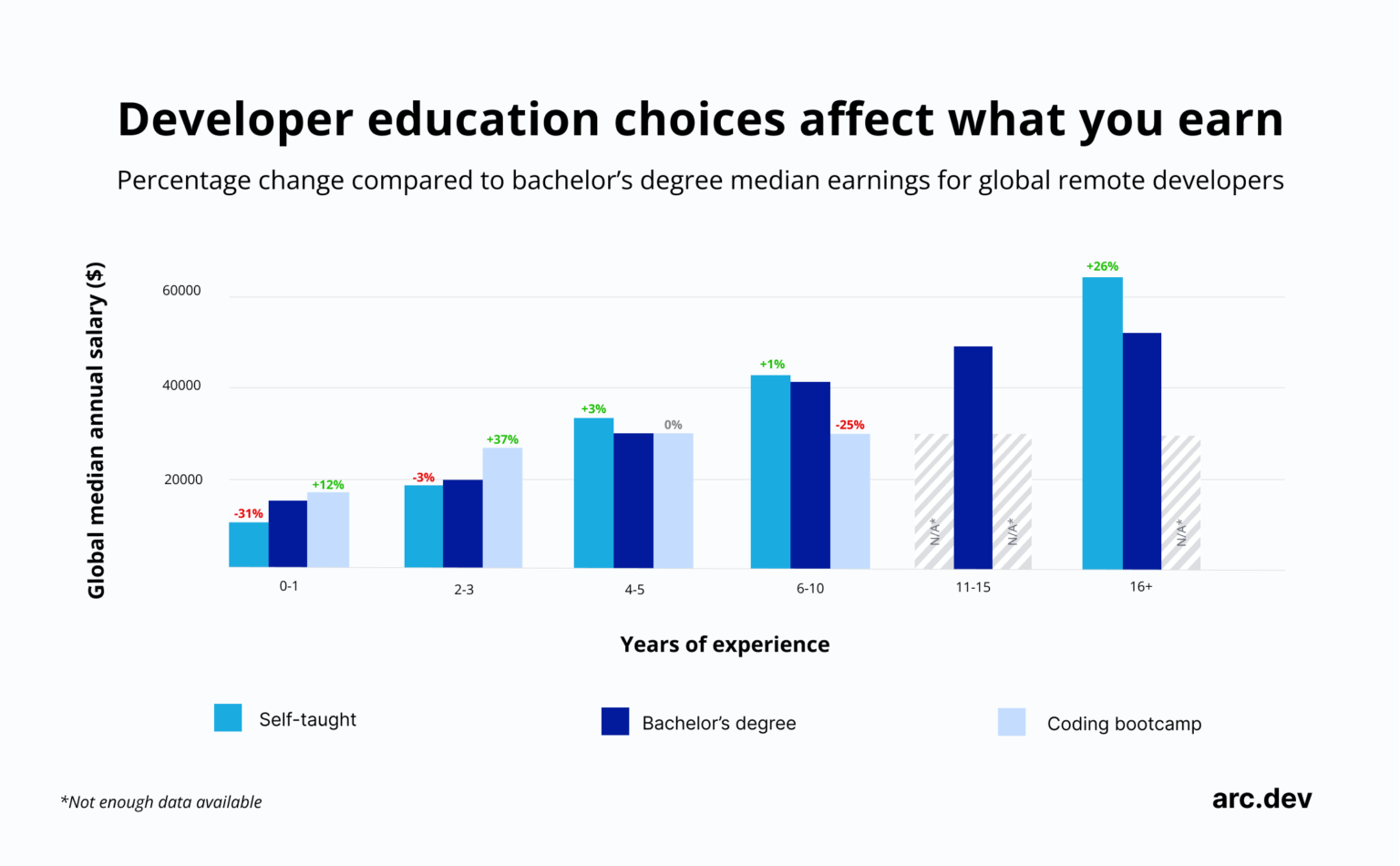
- Course Report and related surveys list average starting salaries for bootcamp grads around $65k to $70k (Course Report example: average $69,079; median $65,000 in reported samples).
- Course Report reports median salary increase after bootcamp $22k to $25k (salary uplift 50% in some datasets). That uplift is a common headline.
- If average tuition is $13k to $14k and median first-job lift is $22k, the simple payback period on tuition (salary lift/tuition) is often under 1 year on paper. Real payback depends on living costs, lost wages during study, taxes, and job stability.
- Role-by-role ranges vary broadly: entry web dev often $55k to $95k depending on city/firm; data roles and specialized security roles can start higher.
- Experience before boot camp matters: students with prior professional experience or degrees often command higher starting salaries.
- Reported averages are skewed by high-paying hubs and by selective reporting; median figures are usually more conservative.
- ROI for employers: Many report bootcamp grads ramp faster in applied tasks vs fresh college grads, depending on the company. Employer surveys show increasing acceptance.
- Salary growth post-hire: Many bootcamp grads see raises and promotions over 2 to 3 years, similar to other entry hires, but long-term career path depends on continued learning.
- Beware of top-end marketing claims (six figures right out of boot camp); these are possible in rare cases and usually in high-cost-of-living markets with strong prior experience.
- For students, evaluating local market salaries and the school’s verified outcomes is crucial for realistic ROI math. CIRR and Course Report make comparisons easier.
| Item | Typical number |
| Avg reported starting salary | $65k to $70k. |
| Median salary uplift | $22k to $25k after graduation. |
| Implied tuition payback | Often 1 year on salary lift alone (ignores living costs). |
Employers and Hiring (Do They Hire Grads?)
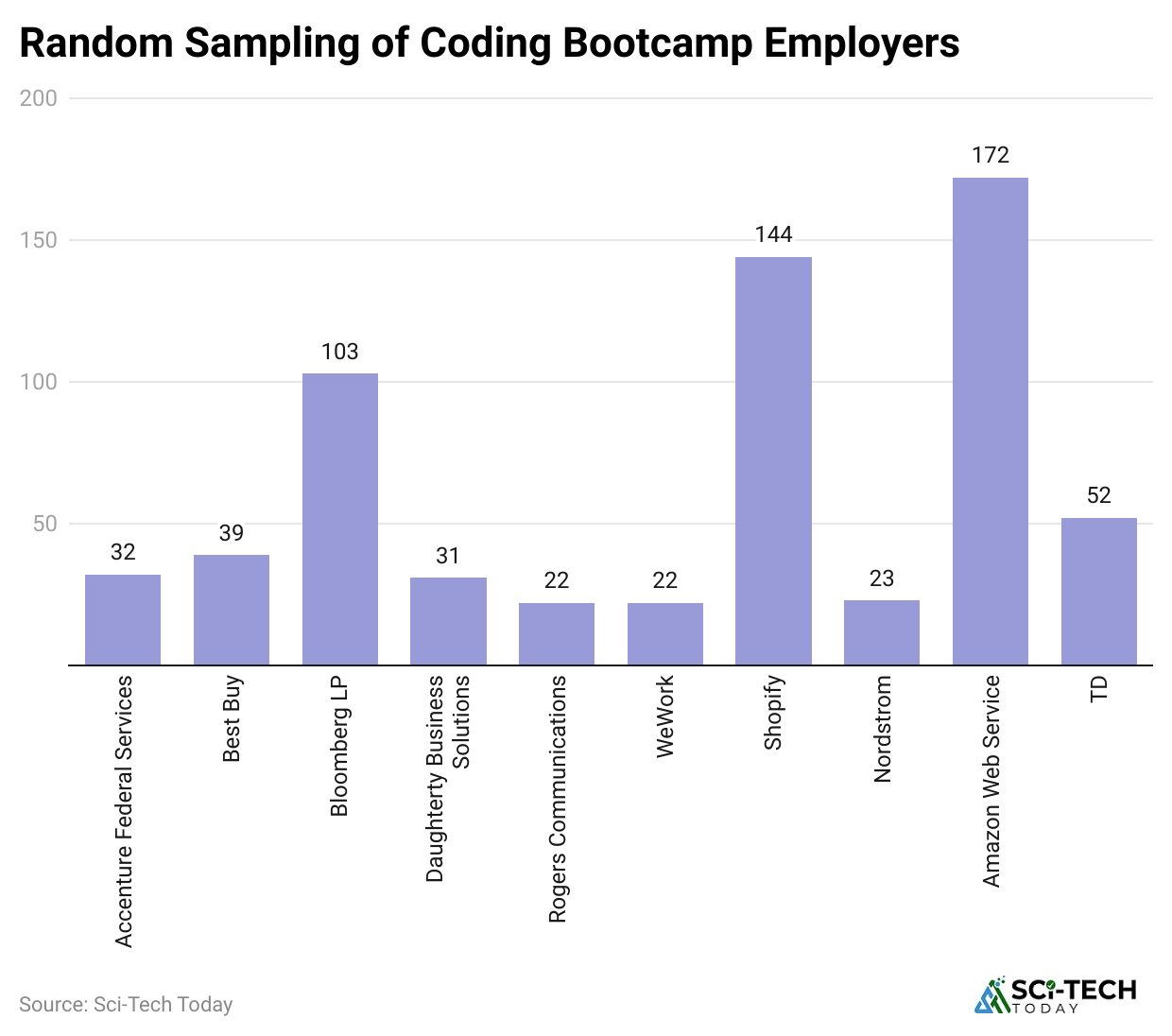
- Employer attitudes are shifting toward skills-based hiring; many public sector and corporate programs actively seek demonstrable skills over specific degrees. Government guidance and private surveys support this movement.
- Course Report/employer surveys show many employers now express confidence in hiring bootcamp grads for entry roles; figures like 50 to 70% confidence levels appear in various surveys. (Depends on sector and survey.)
- Hiring trends: stable industries (healthcare, finance, government) often hire more consistently than big tech during downturns.
- Some employers prefer candidates from specific, well-known bootcamps or from programs with strong corporate partnerships.
- Employers increasingly ask for demonstrable project work, GitHub repos, tests, and take-home projects during interviews and portfolio matters.
- Internship, apprenticeship, and earn-while-you-learn models are growing as employer/bootcamp partnerships.
- Hiring managers report variable quality; top bootcamps produce consistent hires, lesser-known ones show mixed results. Vet outcomes.
- The “degree vs bootcamp” debate: many employers are comfortable hiring bootcamp grads for junior roles when the candidate shows skills and relevant projects. NACE and LinkedIn data show increasing skills-first hiring.
- Soft skills, communication, and teamwork still heavily influence hiring decisions; technical skills alone aren’t enough for many roles.
- Short-term headwinds (AI, layoffs) can reduce openings for junior roles; skills like AI tool integration and security are rising in demand.
| Item | Signal |
| Employer confidence (varied) | Many firms report willingness to hire bootcamp grads; figures vary by survey (50 to 70%+ for some groups). |
| Hiring focus | Skills, projects, adaptability > credentials in many current postings. |
Risks, Criticisms, and Real-World Headwinds
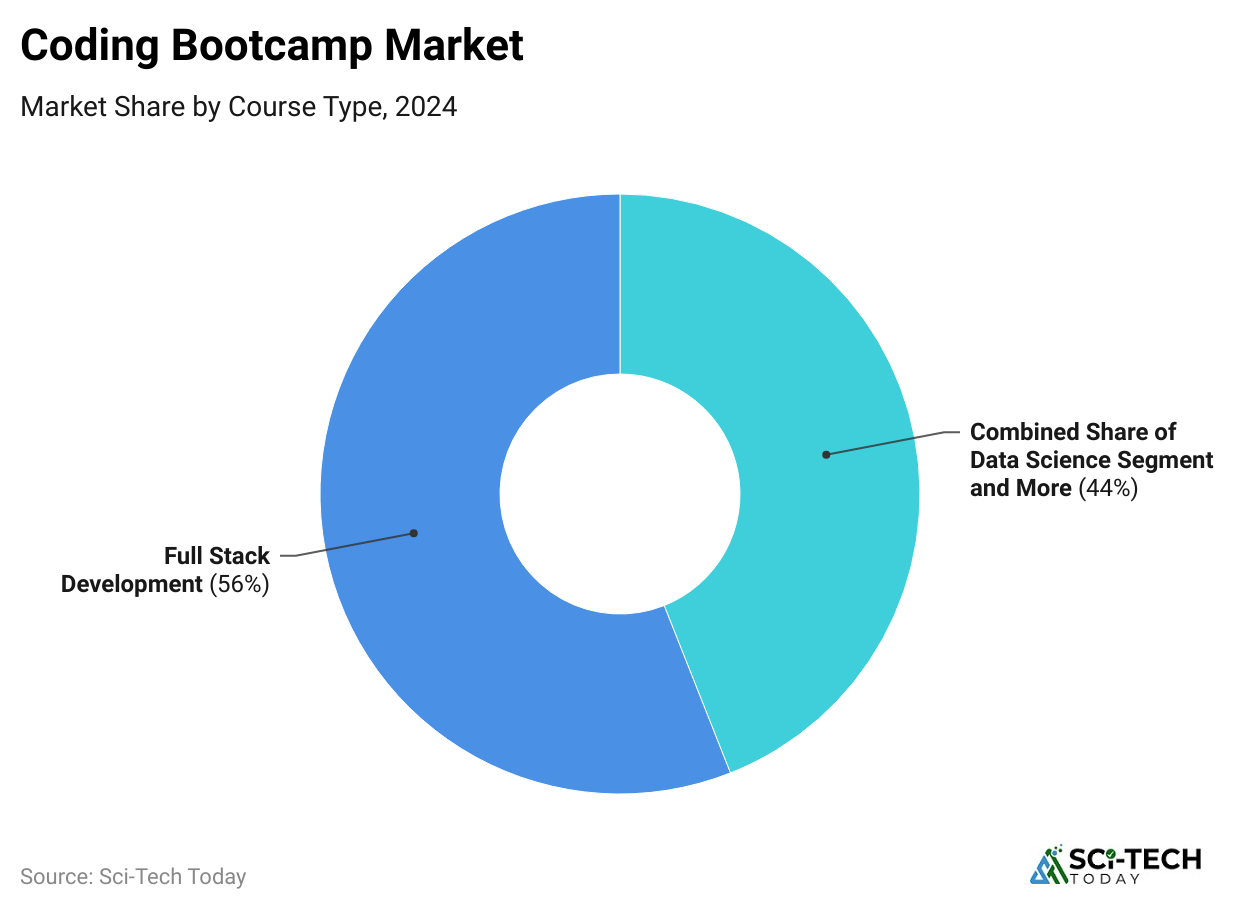
- Outcome variability: not all bootcamps deliver the same results, and placement and salary data vary greatly by school. CIRR exists because this variability matters.
- Misleading marketing & financing abuse: cases like BloomTech/ISAs led to CFPB action in 2024, a clear red flag for students and a reason to read contracts and disclosures.
- Market saturation in some localities, plus tech hiring slowdowns, make placement harder than in prior boom years. Recent reporting ties AI adoption to reduced entry-level demand in places.
- ISAs and deferred payments can hide real costs and risks; regulatory action shows they require careful evaluation.
- Some bootcamps inflated outcomes historically; third-party verification (CIRR) helps identify credible providers.
- Not every graduate secures a role that uses bootcamp skills. Completion does not guarantee a job; career services and student effort are decisive.
- The “six-figure right away” marketing is often unrealistic unless you combine location, prior experience, and luck.
- Quality control and instructor depth vary; cheaper bootcamps often trade instructor quality for scale. Vet instructors and outcomes.
- Employers sometimes still default to university hires for certain roles or senior tracks; bootcamp grads may need extra networking to break in.
- Macro policy and funding shifts (e.g., vet program funding, apprenticeship incentives) can change who pays and who benefits from bootcamps.
| Risk | Why it matters |
| Outcome variability | Impacts ROI; verify with CIRR or audited reports. |
| Financing traps | ISAs/deferred tuition can be risky; CFPB enforcement shows problems. |
| Market shifts | Hiring slowdowns and AI adoption affect entry roles. |
Future Outlook and Recommendations (What Students and Providers Should Do)
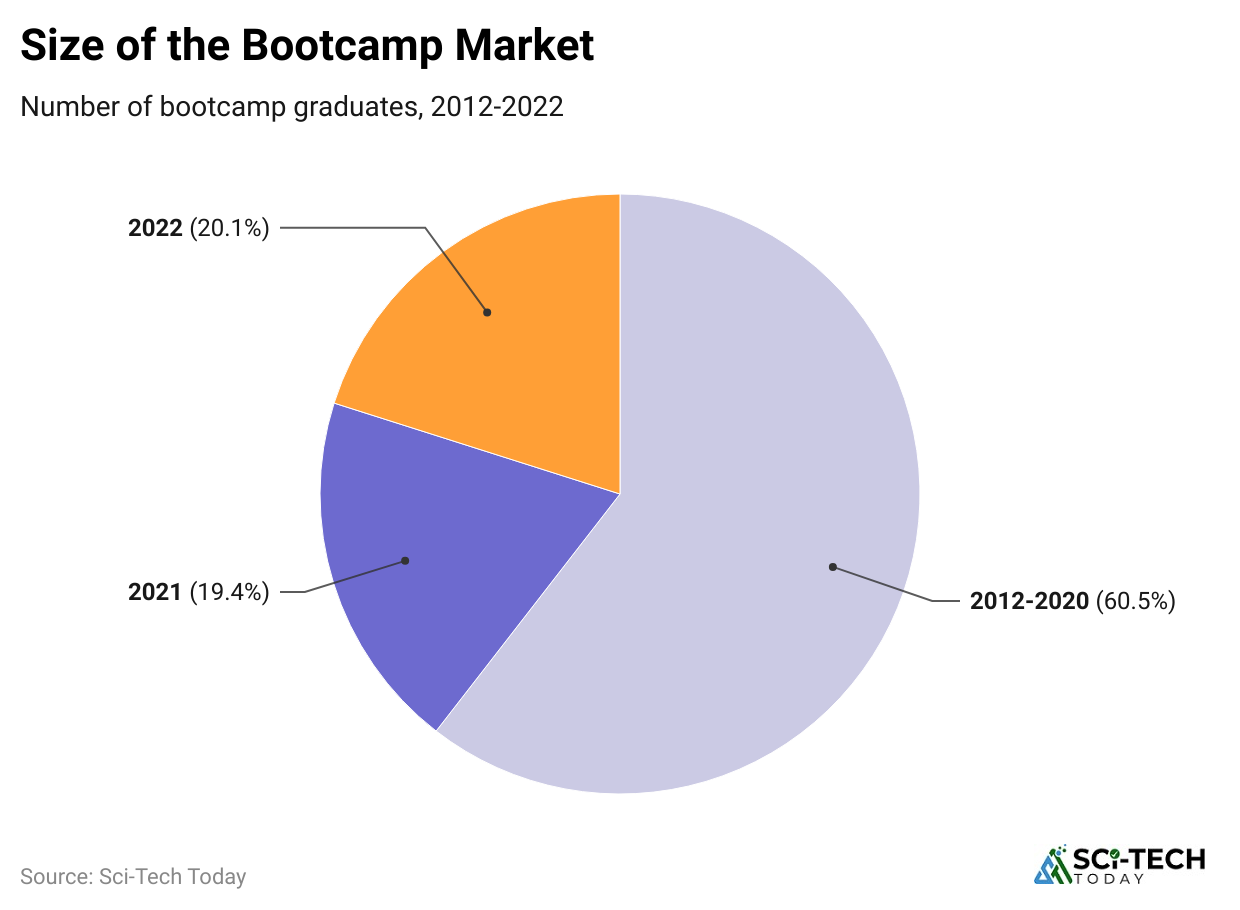
- Short term (next 12 months), expect volatility, localized demand, AI changes, and hiring freezes will affect placements unevenly. Be conservative in expectations.
- Mid-term (2 to 5 years): demand for AI-aware engineering, cybersecurity, data, and cloud skills will grow, and bootcamps that adapt will capture more employer attention.
- Providers that publish audited outcomes (CIRR) and transparent financing will win trust and likely scale better.
- Students should check verified outcomes, median salaries (not cherry-picked top salaries), and read financing & job guarantee terms carefully.
- Focus on demonstrable projects, GitHub, internships, and networking events that still lead to interviews.
- Employers will continue to experiment with apprenticeships, apprenticeships tied to skills checks, and hybrid hiring pathways. Bootcamps that build employer pipelines win.
- Expect continued consolidation: well-run schools, university partnerships, and corporate training will dominate larger shares.
- Watch regulation: more oversight of financing and outcome claims is likely future enforcement is probable if poor practices continue.
- For ROI: do local market research. In some towns, bootcamp ROI is excellent; in others, you need extra experience or relocation to hit high salaries.
- Final practical rule: verify outcomes + compare medians + check job-support before you sign. If a school won’t share audited numbers, be suspicious.
| For whom | Action to take |
| Students | Check CIRR / audited outcomes, median salaries, and financing terms. |
| Providers | Publish transparent outcomes, partner with employers, and add AI/cyber content. |
| Employers | Use skills assessments, apprenticeships, and partner with trusted bootcamps. |
Conclusion
To wrap up this boot camp, statistics show us a lot about how this education model has grown and changed over the years. From beginnings in 2012 to a global market worth billions today, bootcamps have proven they can offer fast, skills-focused training that leads many graduates to new tech careers.
The numbers tell us that while costs can be significant, the potential salary gains and job placement rates often make it worth the investment. Outcomes vary widely between programs, so checking verified data and understanding financing options is key.
Employers are increasingly open to hiring bootcamp grads, especially those with strong portfolios and skills. Looking ahead, the industry will keep evolving, with more focus on AI, cybersecurity, and transparent results. If you’re thinking about joining a bootcamp, use these statistics as your guide, dig into the details, ask the right questions, and pick a program that matches your goals and local job market. I hope you like this statistics article. If you have any questions, kindly let me know in the comments section.
Sources
FAQ.
The average tuition for a full-time coding bootcamp is around $14,600, with part-time programs typically costing about $12,000. Self-paced options are usually cheaper, averaging near $8,600.
Approximately 69,000 students are expected to graduate from coding bootcamps in the U.S. alone in 2024, with numbers growing steadily worldwide.
Most reputable bootcamps report job placement rates between 60% to 80% within 180 days of graduation.
Bootcamp grads typically start with salaries around $65,000 to $70,000, representing a salary increase of about $22,000 to $25,000 from their previous jobs.
Bootcamps can be worth it if you choose quality programs with verified outcomes and clear financing options. Many graduates see a return on investment within a year.
Most students are in their late 20s or early 30s, about 50 to 60% have a bachelor’s degree, and 32 to 36% are women. Many come from non-tech backgrounds looking to switch careers.
About 82% pay tuition upfront, while others use installments (58%), loans (53%), or scholarships (36%). Income share agreements (ISAs) are now rare, making up only about 5% of financing.
JavaScript (including frameworks like React and Node.js), SQL, and Python are the most common languages taught across bootcamps today.
Around 50 to 70% of employers express confidence in hiring bootcamp graduates, valuing practical skills and portfolios more than traditional degrees.
Growth in AI, cybersecurity, cloud computing training, tighter regulation, more employer partnerships, and increased transparency in outcomes are key future trends.

Barry is a technology enthusiast with a passion for in-depth research on various technological topics. He meticulously gathers comprehensive statistics and facts to assist users. Barry's primary interest lies in understanding the intricacies of software and creating content that highlights its value. When not evaluating applications or programs, Barry enjoys experimenting with new healthy recipes, practicing yoga, meditating, or taking nature walks with his child.
